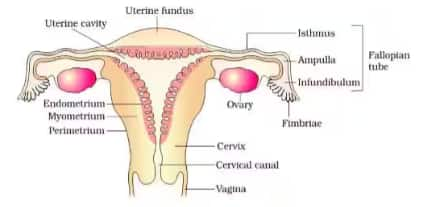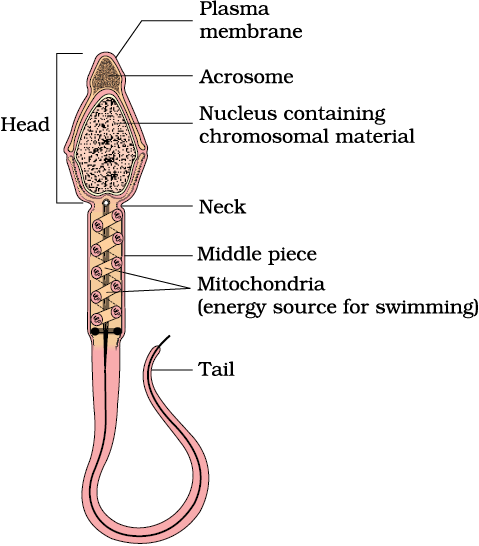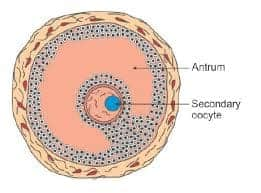NCERT Solutions for Class 12 Biology Chapter 2 (Human Reproduction) – Free PDF Download
CBSE Class 12th Exam Date:17 Feb' 26 - 17 Feb' 26
The NCERT Solutions for Class 12 Biology Chapter 2 Human Reproduction allow students to understand the various components that form the male and female reproductive systems. The important topics include male and female reproductive systems, gametogenesis, menstrual cycle (phases and events), and hormonal regulation. Processes like fertilisation and implantation, embryonic development, parturition, and lactation are also included. Consistent practice of NCERT Solutions helps students score well in the school exams and competitive exams like NEET. To make the concepts more understandable, students can depend on the Human Reproduction Class 12 question answer. In addition to this, students can also download the PDF, which follows the latest NCERT curriculum. Questions from this chapter are frequently asked in the exams, making the PDF a valuable resource.
This Story also Contains
- Download Human Reproduction NCERT Solutions PDF
- Get Class 12 Biology Chapter 2 Human Reproduction Solutions (Exercise Questions)
- Approach to Solve Human Reproduction Class 12 Question Answer
- Important Question of NCERT Class 12 Biology Chapter 2
- What Students Learn from Human Reproduction NCERT Solutions
- What Extra Should Students Study Beyond the NCERT for NEET?
- NCERT Solutions for Class 12 Biology- Chapter-wise
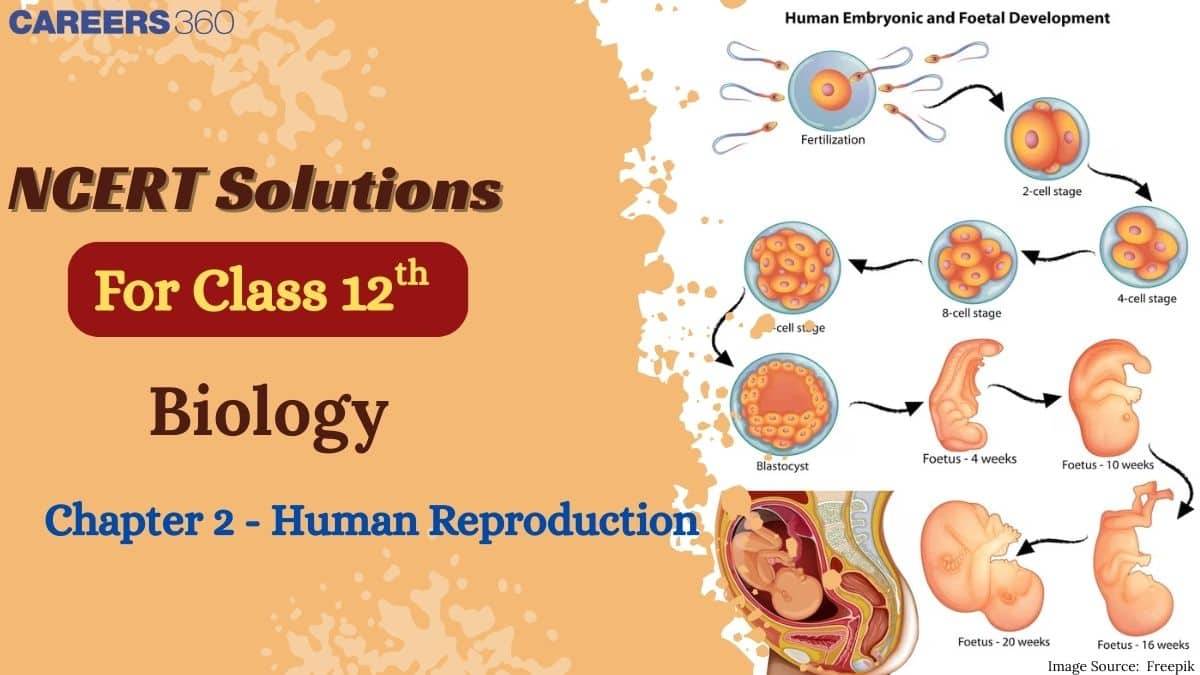
Download Human Reproduction NCERT Solutions PDF
The PDF for the solutions of the chapter Human Reproduction can be downloaded from the link below. The Class 12 Biology Chapter 2 Human Reproduction question answer gives a clear understanding of how humans reproduce and the biological processes involved. The NCERT Solutions for Class 12 provide simple, step-by-step explanations to help make learning easier and more effective.
Also Read,
Get Class 12 Biology Chapter 2 Human Reproduction Solutions (Exercise Questions)
Students can find the complete and well-explained solutions to Chapter Human Reproduction. Working through the Class 12 Biology Chapter 2 Human Reproduction question answer will help students step ahead in achieving better marks in the upcoming board examination and further competitive exams.
(a) Humans reproduce _____________ (asexually/sexually)
(b) Humans are _____________ (oviparous, viviparous, ovoviviparous)
(c) Fertilisation is _____________ in humans (external/internal)
(d) Male and female gametes are _____________ (diploid/haploid)
(e) Zygote is _____________ (diploid/haploid)
(f) The process of release of ovum from a mature follicle is called _____________
(g) Ovulation is induced by a hormone called _____________
(h) The fusion of male and female gametes is called _____________
(i) Fertilisation takes place in _____________
(j) Zygote divides to form _____________which is implanted in uterus.
(k) The structure which provides a vascular connection between the foetus and uterus is called _____________
Answer:
(a) Humans reproduce sexually
(b) Humans are viviparous
(c) Fertilisation is internal in humans
(d) Male and female gametes are haploid
(e) Zygote is diploid
(f) The process of release of an ovum from a mature follicle is called ovulation
(g) Ovulation is induced by a hormone called luteinizing hormone
(h) The fusion of male and female gametes is called fertilisation
(i) Fertilisation takes place in an ampulla of the oviduct (fallopian tube)
(j) The zygote divides to form a blastocyst, which is implanted in the uterus.
(k) The structure that provides a vascular connection between the foetus and the uterus is called the placenta
Q2. Draw a labeled diagram of the male reproductive system.
Answer:
The labelled diagram of the male reproductive system in the human reproduction class 12 is as follows:
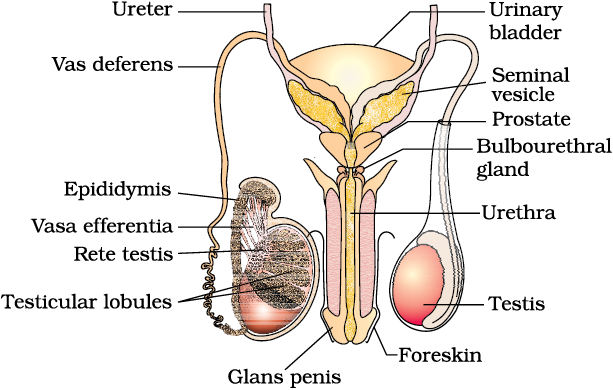
Q4. Write two major functions of each of the testis and the ovary.
Answer:
Functions of the testis
- The testis produces spermatozoa, which are male gametes.
- In the testis, the male sex hormone testosterone is developed.
Functions of the ovary
- The ovary produces an ovum by the process of oogenesis.
- Graafian follicles in the ovary produce a female sex hormone called estrogen.
Q5. Describe the structure of a seminiferous tubule.
Answer:
Seminiferous tubules are highly coiled structures present in testicular lobules. The seminiferous tubules are lined by two types of cells, i.e., spermatogonia and Sertoli cells, from the inside. Spermatogonia are the male germ cells that form sperm through meiotic divisions followed by mitotic division, while Sertoli cells provide nutrition to the germ cells. The region outside the seminiferous tubules is called the interstitial space, and it contains small blood vessels and Leydig cells. The Leydig cells secrete androgens.
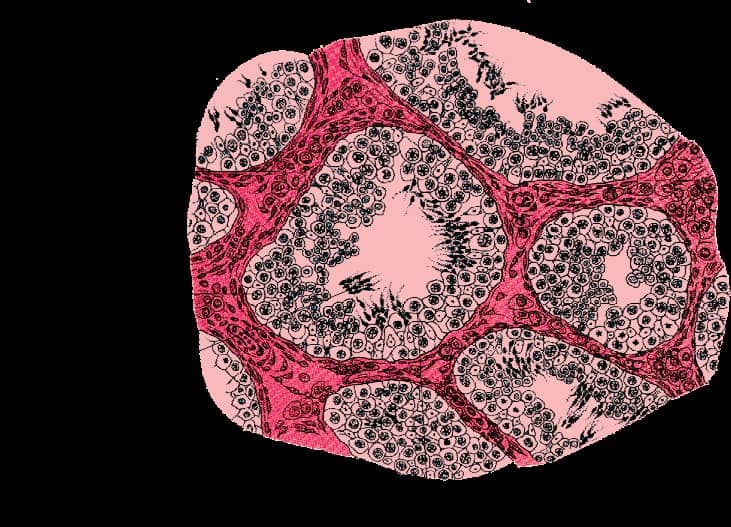
Q6. What is spermatogenesis? Briefly describe the process of spermatogenesis.
Answer:
Spermatogenesis is the process of the formation of spermatozoa from spermatogonia in the testes at the time of puberty. In this process, the spermatogonia present at the inner side of the seminiferous tubules multiply by mitotic division and increase in number. Each spermatogonium contains 46 chromosomes. Spermatogonia form spermatocyte that undergoes meiotic division to produce secondary spermatocytes having 23 chromosomes. The secondary spermatocytes undergo 2nd meiotic division to form spermatids. The spermatids are transformed into spermatozoa by a process called spermiogenesis. The sperm heads remain embedded in the Sertoli cells and are released from the seminiferous tubules by the process of spermiation
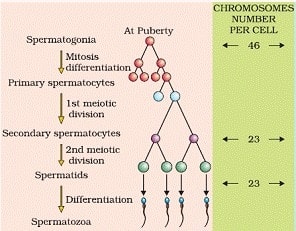
Q7. Name the hormones involved in the regulation of spermatogenesis.
Answer:
Spermatogenesis is initiated due to an increase in the secretion of gonadotropin-releasing hormone by the hypothalamus. An increase in GnRH acts on the anterior pituitary and stimulates the secretion of two gonadotropins, LH (luteinizing hormone) and FSH (follicle-stimulating hormone). Among these, LH acts on Leydig cells and stimulates them to secrete androgens, whereas FSH acts on Sertoli cells and stimulates the secretion of some factors that help in spermiogenesis.
Q8. Define spermiogenesis and spermiation.
Answer:
Spermiogenesis- The spermatids are transformed into spermatozoa by the process called spermiogenesis.
Spermiation- The release of sperm from the seminiferous tubules occurs through a process called spermiation.
Q10. What are the major components of seminal plasma?
Answer:
The major components of seminal plasma are mucous, fructose, calcium, ascorbic acid, certain enzymes, and some secretions of accessory glands.
Q11. What are the major functions of male accessory ducts and glands?
Answer:
Male accessory ducts include the vasa efferentia and epididymis. Vas deferens and rete testis. They transport and temporarily store spermatozoa. Male accessory glands include the seminal vesicle, bulbourethral gland, and prostate gland. These glands secrete fluids that lubricate the female reproductive system and sperm.
Q12. What is oogenesis? Give a brief account of oogenesis.
Answer:
The process of the formation of mature female gametes is called oogenesis. It starts during the embryonic development stage when millions of oogonia (gamete mother cells) are formed in each fetal ovary. The gamete mother cells start division and enter into prophase I of meiotic division and get temporarily arrested. At this stage, they are called primary oocytes. Each primary oocyte is surrounded by a layer of granulosa cells, which is called the primary follicle. The primary follicle gets surrounded by more layers of granulosa cells called secondary follicles that transform into the tertiary follicle that contains a fluid-filled cavity called an antrum. The tertiary follicles further change into the mature follicle called the Graafian follicle, which ruptures to release secondary oocytes (ovum) from the ovary by the process of ovulation.
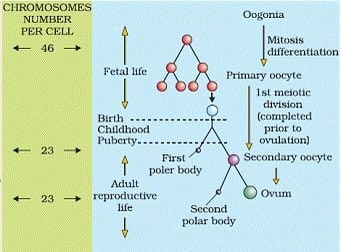
Q13. Draw a labelled diagram of a section through the ovary.
Answer:
A labelled diagram of a section through the ovary is as follows:
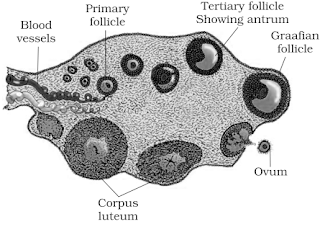
Q15. Name the functions of the following:
(a) Corpus luteum
Answer:
Corpus luteum-
It secretes progesterone. Progesterone is essential for the maintenance of the endometrium.
(b) Endometrium
Answer:
Endometrium- Implantation of the fertilized ovum and many events of pregnancy take place in the endometrium.
(c) Acrosome
Answer:
Acrosome- It is filled with enzymes that hydrolyse the egg membrane, thus helping the sperm in penetration of the ovum during fertilisation.
Q16. Identify True/False statements. Correct each false statement to make it true.
(a) Androgens are produced by Sertoli cells. (True/False)
Answer:
Androgens are produced by Sertoli cells. (False).
Androgens are produced by Leydig's cells.
(b) Spermatozoa get nutrition from Sertoli cells. (True/False)
Answer:
Spermatozoa get nutrition from Sertoli cells. (True)
(c) Leydig cells are found in the testis (True/False)
Answer:
Leydig cells are found in the ovary. (False)
Leydig cells are found in the seminiferous tubules of the testis
(e) Oogenesis takes place in the corpus luteum. (True/False)
Answer:
Oogenesis takes place in the corpus luteum. (False)
Oogenesis takes place in the ovary
(f) Menstrual cycle ceases during pregnancy
Answer:
The menstrual cycle ceases during pregnancy. (True)
Answer:
The presence or absence of a hymen is not a reliable indicator of virginity or sexual experience. (True)
Q17. What is the menstrual cycle? Which hormones regulate the menstrual cycle?
Answer:
Menstrual cycle: The reproductive cycle in female primates is called the menstrual cycle. In a 28-day menstrual cycle, the menses take place on cycle days 3-5. The menstrual cycle consists of phases like the menstrual phase, the follicular phase, the ovulatory phase, and the luteal phase.
Menstrual phase-
1. The production of LH from the anterior lobe of the pituitary gland is reduced.
2. The withdrawal of this hormone causes degeneration of the corpus luteum, and, therefore, progesterone production is reduced.
3. The production of oestrogen is also reduced in this phase.
4. The endometrium of the uterus breaks down & menstruation begins.
5. The cells of endometrium secretions, blood & unfertilised ovum constitute the menstrual flow.
Follicular phase-
1. This phase usually includes cycle days 6-13 or 14 in a 28-day cycle.
2. The follicle-stimulating hormone (FSH) secreted by the anterior lobe of the pituitary gland stimulates the ovarian follicle to secrete estrogens.
3. Oestrogen stimulates the proliferation of the endometrium of the uterine wall.
4. The endometrium becomes thicker by rapid cell multiplication, and this is accompanied by an increase in uterine glands & blood vessels.
Ovulatory phase-
1. Both LH & FSH attain a peak level in the middle of the cycle (about the 14th day).
2. Oestrogen concentration in the blood increases.
3. Rapid secretion of LH induces the rupture of the Graafian follicle and thereby the release of the ovum. LH causes ovulation.
Luteal Phase-
1. Includes cycle days 15 to 28.
2. Corpus luteum secretes progesterone.
3. Endometrium thickens.
4. Uterine glands become secretory.
Hormonal control of the menstrual cycle.
1. FSH stimulates the ovarian follicles to produce oestrogens.
2. LH stimulates the corpus luteum to secrete progesterone.
3. The menstrual phase is caused by the increased production of oestrogens.
4. LH causes ovulation
5. The proliferative phase is caused by the increased production of oestrogens.
6. The secretory phase is caused by increased production of progesterone.
Q18. What is parturition? Which hormones are involved in the induction of parturition?
Answer:
The process of delivery of the foetus is called parturition. The Oxytocin hormone causes a strong contraction of the uterus. The contraction of the uterus becomes stronger and stronger through the stimulatory reflex between uterine contraction and oxytocin secretion. This leads to the expulsion of the baby from the uterus through the birth canal.
Answer:
The sex chromosome in a human female is XX, while in a male it is XY. Thus, female produces haploid gametes with all X chromosomes, but male produces two types of gametes with either X or Y. The sex of the child will be dependent on which sperm, whether the one with X chromosomes or the one with Y chromosomes, fertilises the ovum with an X chromosome. Therefore, the sex of the baby is determined by the father's chromosomes, not the mother's.
Answer:
One ovum is released by a human ovary in a month. Identical twins are developed from a single egg. Hence, only one egg would have been released when the mother gave birth to identical twins. If the twins are fraternal, then they must have been developed from two eggs.
Q21. How many eggs do you think were released by the ovary of a female dog that gave birth to 6 puppies?
Answer:
Dogs are polyovulatory animals, and they release more than one egg at a time. So, a female dog with 6 puppies in one generation releases 6 eggs.
NCERT Solutions for Class 12- Subject-wise
- NCERT Solutions for Class 12 Maths
- NCERT Solutions for Class 12 Chemistry
- NCERT Solutions for Class 12 Physics
Approach to Solve Human Reproduction Class 12 Question Answer
To solve questions from Human Reproduction easily, follow these important points and understand the main concepts clearly.
- Firstly, it's important for students to understand the male and female reproductive systems' structure and function well.
- Students can learn about the hormonal control of reproductive processes, such as puberty and the menstrual cycle, as given in the Class 12 Biology Chapter 2 Human Reproduction question answer.
- Focus should be placed on the phases of gametogenesis, such as spermatogenesis and oogenesis.
- Learn the process of fertilisation, implantation, and embryonic development in order.
- Practice well-labelled diagrams of male/female reproductive organs, and the development stages of the embryo, provided in the Class 12 Biology Chapter 2 Human Reproduction Solutions.
- Regular practice of previous year questions and NCERT Solutions Class 12 Biology helps students understand the exam pattern better.
Also, check the NCERT Books and the NCERT Syllabus here:
Important Question of NCERT Class 12 Biology Chapter 2
Here is a key question from the chapter that can help students strengthen their understanding and prepare well for exams. For more such questions and answers, students can refer to the NCERT Solutions for Class 12 Biology Chapter 2 Human Reproduction to gain clarity on the concepts.
Question: Seminal plasma, the fluid part of semen, is contributed by.
i. Seminal vesicle
ii. Prostate gland
iii. Urethra
iv. Bulbourethral gland
Options
i and ii
i, ii, and iv
ii, iii, and iv
i and iv
Answer: The correct answer is option (2) (i), (ii), and (iv).
Explanation:
The urethra does not contribute to seminal plasma. The urethra has no contribution to seminal plasma, as it primarily serves as a passage for urine and semen. Seminal plasma is produced by accessory glands like the seminal vesicles, prostate gland, and bulbourethral glands. These glands secrete fluids that provide nutrients, lubrication, and protection to sperm. The urethra simply acts as a conduit for semen during ejaculation. Despite its role in sperm transport, it does not add any secretions to the seminal fluid.
NCERT Exemplar Class 12 Solutions
- NCERT Exemplar Class 12 Chemistry Solutions
- NCERT Exemplar Class 12 Mathematics Solutions
- NCERT Exemplar Class 12 Physics Solutions
What Students Learn from Human Reproduction NCERT Solutions
Students studying through these solutions will know about the male and female reproductive systems' functions. Other important things that they learn are given below:
Learners will understand the detailed structure and function of the primary and secondary sex organs of males and females.
Students will explore the hormonal control of male and female reproductive systems using the Human Reproduction NCERT Solutions.
Learners will gain knowledge on processes like fertilisation, implantation, gastrulation, and embryonic development.
Students will understand reproductive disorders, menstrual cycle abnormalities, parturition, and lactation, as given in the Human Reproduction Class 12 question answer.
What Extra Should Students Study Beyond the NCERT for NEET?
Below is a table highlighting the key topics from the chapter that students should focus on for NEET preparation, beyond the NCERT. By referring to the NCERT Solutions for Class 12 Biology Chapter 2 Human Reproduction, students can make these topics clear without any confusion.
NCERT Solutions for Class 12 Biology- Chapter-wise
Here is a chapter-wise table with direct links to NCERT solutions for easy and quick access:
Frequently Asked Questions (FAQs)
The important topics of the NCERT Solutions for Class 12 Biology Chapter 2 Human Reproduction are given below:
- The Male Reproductive System
- The Female Reproductive System
- Gametogenesis
- Menstrual Cycle
- Fertilization and Implantation
- Pregnancy and Embryonic Development
- Parturition and Lactation
Spermatogenesis occurs continuously in the testes and produces four sperm from one cell, while oogenesis occurs cyclically in the ovaries, producing one egg and three polar bodies from one cell.
Hormones are crucial for human reproduction, regulating puberty, menstrual cycles, sperm production, and pregnancy, impacting both male and female reproductive systems.
Fertilization is the fusion of sperm and egg. It occurs in the fallopian tubes (oviducts), where the fertilized egg (zygote) then travels to the uterus for potential implantation and pregnancy. Detailed explanations of this process are included in the Human Reproduction Class 12 NCERT Solutions, which help students understand the concept clearly.
Amniotic fluid also helps protect the fetus from infectious agents due to its inherent antibacterial properties. Additionally, it serves as a pool of fluid and nutrients for the fetus containing: proteins, electrolytes, immunoglobulins, and vitamins from the mother.
Questions related to CBSE Class 12th
On Question asked by student community
Hello,
The date of 12 exam is depends on which board you belongs to . You should check the exact date of your exam by visiting the official website of your respective board.
Hope this information is useful to you.
Hello,
Class 12 biology questions papers 2023-2025 are available on cbseacademic.nic.in , and other educational website. You can download PDFs of questions papers with solution for practice. For state boards, visit the official board site or trusted education portal.
Hope this information is useful to you.
Hello Pruthvi,
Taking a drop year to reappear for the Karnataka Common Entrance Test (KCET) is a well-defined process. As a repeater, you are fully eligible to take the exam again to improve your score and secure a better rank for admissions.
The main procedure involves submitting a new application for the KCET through the official Karnataka Examinations Authority (KEA) website when registrations open for the next academic session. You must pay the required application fee and complete all formalities just like any other candidate. A significant advantage for you is that you do not need to retake your 12th board exams. Your previously secured board marks in the qualifying subjects will be used again. Your new KCET rank will be calculated by combining these existing board marks with your new score from the KCET exam. Therefore, your entire focus during this year should be on preparing thoroughly for the KCET to achieve a higher score.
For more details about the KCET Exam preparation,
CLICK HERE.
I hope this answer helps you. If you have more queries, feel free to share your questions with us, and we will be happy to assist you.
Thank you, and I wish you all the best in your bright future.
Yes, you can switch from Science in Karnataka State Board to Commerce in CBSE for 12th. You will need a Transfer Certificate from your current school and meet the CBSE school’s admission requirements. Since you haven’t studied Commerce subjects like Accountancy, Economics, and Business Studies, you may need to catch up before or during 12th. Not all CBSE schools accept direct admission to 12th from another board, so some may ask you to join Class 11 first. Make sure to check the school’s rules and plan your subject preparation.
Hello
For the 12th CBSE Hindi Medium board exam, important questions usually come from core chapters like “Madhushala”, “Jhansi ki Rani”, and “Bharat ki Khoj”.
Questions often include essay writing, letter writing, and comprehension passages. Grammar topics like Tenses, Voice Change, and Direct-Indirect Speech are frequently asked.
Students should practice poetry questions on themes and meanings. Important questions also cover summary writing and translation from Hindi to English or vice versa.
Previous years’ question papers help identify commonly asked questions.
Focus on writing practice to improve handwriting and presentation. Time management during exams is key to answering all questions effectively.
Popular CBSE Class 12th Questions
Applications for Admissions are open.
This ebook serves as a valuable study guide for NEET 2025 exam.
NEET Previous 10 Year Questions
Get nowThis e-book offers NEET PYQ and serves as an indispensable NEET study material.
JEE Main Important Physics formulas
Get nowAs per latest syllabus. Physics formulas, equations, & laws of class 11 & 12th chapters
JEE Main Important Chemistry formulas
Get nowAs per latest syllabus. Chemistry formulas, equations, & laws of class 11 & 12th chapters
JEE Main high scoring chapters and topics
Get nowAs per latest 2024 syllabus. Study 40% syllabus and score upto 100% marks in JEE
JEE Main Important Mathematics Formulas
Get nowAs per latest syllabus. Maths formulas, equations, & theorems of class 11 & 12th chapters
